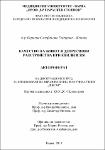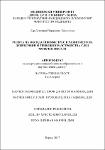| dc.creator | Мандова, Райна | BG |
| dc.creator | Mandova, Rayna | EN |
| dc.date.accessioned | 2019-08-09T09:27:14Z | |
| dc.date.available | 2019-08-09T09:27:14Z | |
| dc.date.issued | 2013 | |
| dc.identifier.uri | http://repository.mu-varna.bg/handle/nls/177 | |
| dc.description.abstract | Афективните разстройства представляват особена група, която се характеризира с първично разстройство на настроението като депресия или мания и включва две основни диагнози: рекурентно депресивно разстройство и биполярно афективно разстройство. Това, което се нарича „афективен спектър”, включва и други диагнози, които не са обект на нашето проучване. Рекурентното депресивно разстройство и биполярното депресивно разстройство са хронични заболявания, които засягат значим процент от населението, свързани с висок процент психиатрична и соматична коморбидност, неработоспособност и инвалидизация и не на последно място със страдание за пациента и близките му. Целта на изследването е да се идентифицира и оцени произхода, спецификата и значението на резидуалните (подпрагови и надпрагови) депресивни симптоми в сравнителен план при рекурентна и биполярна депресия и тяхната евентуална връзка със социодемографски характеристики, специфики в динамиката на заболяването, черти на личността, стратегии за справяне, социално функциониране, стресогенни житейски събития и соматични заболявания. Въпросът за диагностичните граници между рекурентната и биполярната депресия стои на вниманието на изследователите и клиницистите от много десетилетия. Регистрираната от нас връзка между личностни черти и резидуалната подпрагова депресия подсказва, че някои, а може би и всички ППС имат двойна генеза- биологична и психологична, като може би относителният дял на тези фактори е различен при различните симптоми. Специално при тревожните симптоми, ролята на личностовата предиспозиция оказва може би водещо значение. Налага се изводът, че психологичната терапия има основно място в комплексното лечение на резидуалните подпрагови симптоми при депресия в рамките на афективни разстройства. ПРИНОСИ С ОРИГИНАЛЕН ХАРАКТЕР: За първи път е проведено проспективно, лонгитудинално проучване с проследяване за 6 месеца на динамиката на РДР и БАР след индексен депресивен епизод. Разработена е методология на проучването и на тази основа е конструиран специфичен изследователски подход с оценъчни и самооценъчни клинични и психологични инструменти. Разработен е по-детайлно проблема за подпраговите симптоми при РДР и БАР и са получени собствени данни за спецификата и значението на ППС в протичането на ремисията и възстановяването след епизод на депресия. Проследена е еволюцията на подпраговите и надпраговите симптоми в сравнителен план при РДР и БАР депресия. Очертани са важни различия в протичането на рекурентната и биполярната депресия, както и факторите, допринасящи за това, което спомага за развитието на въпроса за краткосрочната и средносрочната прогноза при тези разстройства. За първи път в психиатрични проучвания у нас се използва петфакторния модел на личността(NEO-PIP), с помощта на който се откриват корелации между личностовите черти и резидуалната подпрагова депресия и се очертава личностния профил на пациентите с рекурентна и биполярна депресия. Отностно произхода на резидуалните подпрагови симптоми, анализа на данните показва, че тревожността и анхедонията имат двойна детерминираност, като тревожността корелира в по-голяма степен с определени личностови черти, отколкото анхедонията. | BG |
| dc.description.abstract | Affective disorders represent a special group characterized by primary mood disorder such as depression or mania and includes two main diagnoses: recurrent depressive disorder and bipolar affective disorder. The ‘affective spectrum’ includes other diagnoses as well which are not the subject of this study. Recurrent depressive disorder and bipolar depressive disorders are chronic diseases affecting a significant percentage of the population and are related to high percentage of psychiatric and somatic comorbidity, disability and disability, not the least suffering for the patient and his/hers family and friends. This study’s objective is to identify and assess the origin, specifics and significance of the residual (subthreshold and suprathreshold) depressive symptoms in comparison with recurrent and bipolar depression and their potential correlation to socio-demographic characteristics, specifics of the dynamics of the disease, personality traits, coping strategies, social functioning, stressful life events and somatic diseases. For decades the issue of diagnostic boundaries between recurrent and bipolar depression stands at the attention of researchers and clinicians alike. The correlation between personality traits and residual subthreshold depression registered by us, suggests that some, or perhaps all, subthreshold symptoms have double genesis - biological and psychological, the share of these factors varying with the diversity of symptoms. The role of personality predisposition has perhaps paramount importance, especially in terms of the alarming symptoms. It is clear that psychological therapy has a principal place in the complex treatment of residual subthreshold symptoms in depression within the range of affective disorders. Original Contributions: A prospective longitudinal study monitoring for six months the dynamics of bipolar affective disorder and recurrent depressive disorder after an index depressive episode is conducted for the first time. A methodology of the study was developed based on which a specific research approach with clinical and psychological evaluation and self-evaluation tools was designed. The problem of subthreshold symptoms in bipolar affective disorder and recurrent depressive disorder is exploited in details receiving one’s own data for the specifics and importance of subthreshold symptoms in the course of remission and recovery from a depression episode. The evolution of subthreshold and suprathreshold symptoms is analyzed in comparative perspective regarding bipolar affective disorder and recurrent depressive disorder respectively. Important variances in the course of recurrent and bipolar depression are outlined, as well as the factors contributing to the development of short- and medium-term prognosis for these disorders. The five-factor personality model (NEO-PIP) is applied for the first time in psychiatric studies in this country to determine correlations between personality traits and residual subthreshold depression and to outline the personal profile of patients with recurrent and bipolar depression. Regarding the origin of residual subthreshold symptoms, analysis of the data shows that anxiety and anhedonia bear twofold determination as anxiety correlates more closely with certain personality traits than anhedonia. | en_US |
| dc.publisher | Medical University of Varna | en_US |
| dc.subject | psychiatry | en_US |
| dc.subject | depression | en_US |
| dc.subject | Residual Depressive Symptoms | en_US |
| dc.subject | Subthreshold Symptoms | en_US |
| dc.subject | recurrent depressive disorder | en_US |
| dc.subject | bipolar affective disorder | en_US |
| dc.subject | five-factor personality model | en_US |
| dc.subject.classification | Психиатрия и медицинска психология / Psychiatry and Medical Psychology | en_US |
| dc.title | Prospective Longitudinal Study of the Origin, Specifics and Significance of Residual Depressive Symptoms (Focusing on Subthreshold Symptoms) in Recurrent and Bipolar Depression // Проспективно, лонгитудинално проучване на произхода, спецификата и значението на резидуалните депресивни симптоми (с фокус подпрагови симптоми) при рекурентна и биполярна депресия | en_US |
| dc.type | thesis | en_US |
| eprmuv.creator.email | Mandova.Rayna@mu-varna.bg | en_US |
| eprmuv.department | Катедра по психиатрия и медицинска психология / Department of Psychiatry and Medical Psychology | en_US |
| eprmuv.institution | Medical University of Varna | en_US |
| eprmuv.pages | 157 | en_US |
| eprmuv.publication.place | Varna | en_US |
| eprmuv.thesis.degree | phd | en_US |
| eprmuv.thesis.type | doctoral | en_US |



